|
Special Features





Image Libraries


|
|
Blog
Got one of the experimental rubber-floor railcars on the morning commute today. Yes, BeyondDC is the sort of nerd who takes cell phone pictures on the Metro because it’s a fabulous new railcar
No more “spot the carpet stain” – one favorite Metro game would be gone for good.
Average Rating: 4.7 out of 5 based on 292 user reviews.
December 31st, 2008 | Permalink
Tags: transportation

GGW has a post up making the case for Arlington’s Lee Highway corridor as the next Columbia Pike. GGW suggests the corridor could be transformed from a series of strip malls into a genuine urban boulevard, with a string-of-pearls of walkable neighborhood centers, connected by a streetcar.
It’s a great vision, and someday it will happen. It’s such a natural low-hanging fruit type of corridor that such redevelopment is probably inevitable. Arlington’s long range transit plan already identifies Lee Highway and Glebe Road as the most important transit corridors in the county without existing or planned rail service. In another decade or so, when the Columbia Pike and Potomac Yards transitways are finished, the county will probably turn its attention to Lee Highway.
But what about after that?
It’s long been assumed that the Route 50 corridor is hopeless. It’s too oriented for high-speed auto traffic and has no potential walkable nodes. It’s a car sewer, for better or worse.
But is it really? Living in nearby Ballston, we’ve often wondered what could be done with Route 50 if the possibility for radical change ever made it onto the table. If it were politically feasible to convert 50 from a highway into a surface street and use some of its width for a transit line, could neighborhoods be built around it? Could 50 become the new Wilson Boulevard?
BeyondDC sat down at our computer and came up with the following plan. Pink is the Route 50 corridor, along with adjacent land that could be suitable for redevelopment. The green dots are potential transit stations.

A possible Route 50 redevelopment plan for Arlington. Click to enlarge.
Surprisingly, there does seem to be room for a series of mixed-use, walkable neighborhoods along the corridor, in spaces that would leave the adjacent low-density neighborhoods in tact. It would be extremely difficult, of course. Not only would the roadway itself require an absolutely massive overhaul, but the Federal government would have to open up Fort Myer and Arlington Hall to development, which is unlikely to say the least.
So if it’s not exactly realistic to expect an urban Route 50 any time in the immediate future, it does at least seem physically possible. Maybe, when Columbia Pike and Lee Highway have met their potential, Route 50 can get some love.
We can only hope.
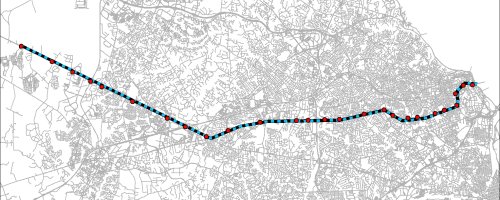
The route could be extended west, where the City of Fairfax is already talking about beefed-up transit and walkable nodes. Click the map to enlarge.
Update 12/31: To clarify, this isn’t anything that could be seriously proposed any time soon. It wouldn’t be appropriate (or feasible) for a “real” plan to suggest such drastic redevelopment on any near term time scale. The constraints are unreasonable to try to tackle while Columbia Pike and Lee Highway are still hanging out there. The point of this exercise isn’t so much to ask “should we do this now” as it is to ask “could we do this if we wanted to”. In 2008 there is no question: We don’t want to. But in 40 years when Route 29 and the Pike are nearing build-out in the manner that Rosslyn-Ballston is now, and when gas prices have had another couple of decades to creep up, it could be a place like Route 50 becomes obsolete and needs a plan like this.
Average Rating: 4.8 out of 5 based on 230 user reviews.
December 30th, 2008 | Permalink
Tags: featured post, master planning, transportation

As of Sunday, December 28, Phoenix’s Valley Metro light rail system is officially open for business. It brings rail transit to what had been the largest metropolitan area in the United States without such service, and adds another success story to light rail’s increasingly impressive resumé.
If light rail and streetcars can work in car-oriented cities the likes of Phoenix, Houston and Charlotte, surely they can work as a part of our transportation system in more transit-friendly Washington.

Neato.
For more images, see the grand opening thread at SkyscraperPage and flickr.
Average Rating: 4.4 out of 5 based on 245 user reviews.
December 28th, 2008 | Permalink
Tags: transportation

|

Some happy Ballston condo-dweller’s Christmas tree. |
At BeyondDC we check the news every day. If there’s something interesting going on, we write about that. If not, we fall back on a long queue of potential topics saved for rainy days.
But let’s be honest. We’re not going to be sticking with that schedule over the next week or so. Maybe there will be some posts, but it’s just as likely not. There certainly won’t be one every day.
So have a happy holiday week and come see us again in the new year.
Average Rating: 4.7 out of 5 based on 217 user reviews.
December 24th, 2008 | Permalink
Tags: site

|

Potential alignments for the CCT. Click to enlarge and clarify. |
There’s been a lot of news about the Purple Line lately. Most importantly that MoCo planners endorse the light rail option. But the Corridor Cities Transitway hasn’t been without news itself. Planning is moving along on it as well, and according to MTA, the CCT may be able to secure private funding and bypass the cumbersome and unpredictable federal process. That would be good news, since getting all three of Maryland’s light rail projects (including Baltimore’s Red Line) through the federal New Starts program would be difficult.
Also, buried near the bottom of a Gazette story about a Gaithersburg biotech company is this nugget:
A Corridor Cities Transitway stop was planned in Quince Orchard Park to accommodate commuters to MedImmune’s campus. In March, city leaders recommended moving the stop to the other side of Great Seneca to help draw visitors to the Kentlands Commercial District. By the end of the spring, state planners hope to determine the impacts of realigning the CCT.
A possible realignment to the south side of Great Seneca Highway is fabulous news. It’s one of several route adjustments BeyondDC recommended (along with others, including ACT) that would improve the route substantially.
Average Rating: 4.8 out of 5 based on 300 user reviews.
December 24th, 2008 | Permalink
Tags: transportation

|
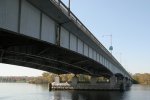
Roosevelt Bridge
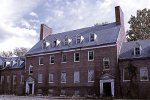
Glenn Dale Hospital

Association of Auto Dealers |
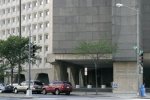
HUD

Lauinger Library
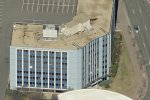
Marymount Ballston |
Yesterday’s Post ran a feature about the Washington region’s ugliest buildings. The Post took reader nominations and choose six of its “favorites”. The results are below and at right, along with BeyondDC’s impressions.
- Roosevelt Bridge: The bridge carrying I-66 over the Potomac River is pretty ugly, but there’s just enough of a place in our heart for exposed structure that we feel like it maybe doesn’t belong on the short list. Also, BeyondDC can’t help but think about that time we tried to cross it on foot to get from the Kennedy Center to Rosslyn. That was a mistake. Don’t try that.
- Glenn Dale Hospital: The PG County building isn’t so much ugly as run-down. Fix the place up and it would be pretty handsome.
- Association of Auto Dealers: Tysons Corner is full of terrible architecture, but this is surely the worst of the lot. It combines lazy modernism done on the cheap with pointless brutalism that doesn’t even maintain the intellectual honesty of actual brutalism. Definitely one of the ugliest buildings around.
- HUD: Speaking of brutalism… blech. The key building of the Southwest DC urban renewal vomitscape was the first thing that came to BeyondDC’s mind when we thought of DC’s worst buildings.
- Lauinger Library, Georgetown: You know that really pretty spire that’s the defining landmark of Georgetown University? You know that massive concrete bunker in front of it that blocks the view of the spire from the Potomac? Yeah, good call. Brutalism is on a streak here.
- Marymount University, Ballston Campus: The architectural equivalent of a middle-schooler’s myspace page with so many clashing colors and obnoxious .gifs that you want to run screaming from the room shouting “OW MY EYES!”. Marymount’s building would be an unattractive but unextraordinary example of mid-century modernism if not for the tacky blue color scheme. Honorable mention goes to the building next door, which was just recently completed and, inexplicably, took several design cues from its illustrious neighbor.
What do you think? If we were to construct a top-10, what should we include?
Average Rating: 5 out of 5 based on 191 user reviews.
December 22nd, 2008 | Permalink
Tags: architecture

Notepad, bought this weekend at the gift shop in Chinatown’s Museum of Crime and Punishment. From Knock Knock Nifty Notes:
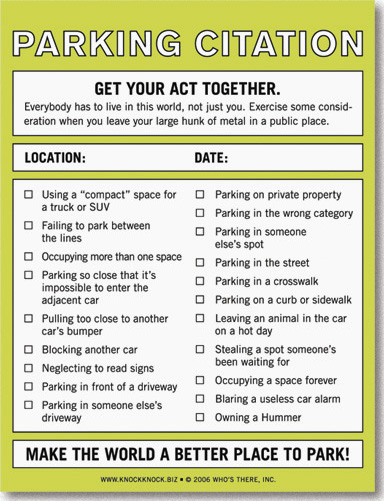
Good start, but needs a box for “Blocking bike lane”.
Average Rating: 4.5 out of 5 based on 173 user reviews.
December 21st, 2008 | Permalink
Tags: fun

|

Norfolk’s light rail will be called “The Tide”. |
Americans are driving less, even with gas prices temporarily down below $2/gallon. This is great news, except that it means gas tax revenue is way down. The gas tax only accounts for a fraction of total infrastructure spending in this country, but is the main source of revenue for the 50 state departments of transportation, who receive money from the federal government based on a pre-determined formula. With less tax revenue, all the state DOTs are slashing their budgets left and right.
Virginia cut half a billion in October, Maryland followed in November, and now Virginia is at it again. The Commonwealth Transportation Board, the body that controls Virginia transport spending, yesterday slashed $2.2 billion from its 6-year construction program.
But the news is not all bad. Bush DOT boss Mary Peters’ solution to this problem at the federal level was to cut transit spending to preserve the highway budget. Virginia, it turns out, is a lot more forward-thinking.
The cuts, at least in Northern Virginia, target projects that were questionable to begin with. $55 million to repave I-66? Gone. $29 million to do one of three spot widenings on I-66 in Arlington (against Arlington’s will)? Gone. New or expanded interchanges across Northern Virginia? See ya later.
On the other hand, the transit budget is more or less intact. Of course it was smaller to begin with, and there are some cuts, but the commonwealth did not cut Dulles Metro, did not cut Norfolk light rail, and in fact may expand intercity rail service from Washington to Richmond and Lynchburg.
Just a few years ago this sort of scenario would have been unthinkable. That a state like Virginia recognizes the importance of transit in such lean times is extremely encouraging.
Average Rating: 4.5 out of 5 based on 162 user reviews.
December 19th, 2008 | Permalink
Tags: government, transportation

The urbanist blogosphere has been atwitter with disappointment about the number of road projects likely to be included in Obama’s infrastructure stimulus package. The exception has been the economist Avent, with whom BeyondDC agrees.
With the stimulus, it seems some are expecting not-yet-President Obama to take the first big step away from the roads-first mentality of the 20th Century. Unfortunately, that is probably not possible given the nature of what the stimulus is all about.
The stimulus package is not intended to change anything except the economy. To have an effect on the economy, it needs to provide immediate jobs. To provide immediate jobs, the stimulus package has to target projects that are already totally through the planning process and ready for construction. The federal planning process takes years. If we wait for new projects to go through it, it will be too late to make any difference to the current economic situation.
Given the nature of transportation planning over the past decade, there are a lot of road projects ready to go and not very many transit projects. This is unfortunate, but it’s not Obama’s fault, nor is there anything he can do about it. Obama may be the country’s first urbanist president, but he’s not a wizard. He can’t travel magically back in time and change planning that happened last year. Thus, the stimulus package is necessarily full of road projects.
If anyone disagrees with the need for an infrastructure stimulus package in the first place, that’s reasonable. But if we are to launch such a package, a lot of road projects will necessarily be included, because road projects are what’s ready to go right now.
Next year Congress will take up the issue of infrastructure spending over the next 6 years via its authorization of the next TEA bill. *That* bill is where Obama and the transit camp have room to move. *That’s* where we should focus our attention, as urbanists. Getting too upset about the stimulus package including roads is unrealistic, and needlessly costs Obama political capital he will need when it comes time to write a bill that actually can move in the right direction.
Now, on the subject of being disappointed with Obama, tapping a rural Republican for DOT boss might be a better reason. BeyondDC doesn’t know much about this LaHood character, except that he’s a moderate from rural Illinois and is supposedly a supporter of Amtrak. If it’s fair to say the pick is at least probably a big step up from Mary Peters, it’s also fair to say the pick isn’t as progressive as we’d hoped.
Average Rating: 4.7 out of 5 based on 282 user reviews.
December 17th, 2008 | Permalink
Tags: economy, government, people, transportation

|



From top to bottom: HSR in Japan, Taiwan, Germany. |
From Reuters:
The U.S. Department of Transportation put out a request for proposals on Monday to build 11 high-speed rail lines across the country, taking a step that is rare in the United States by including the private sector in a major national infrastructure project.
The deadline for receiving the proposals is September 2009, and commissions of “stakeholders” such as the national rail company Amtrak, will evaluate them before passing them on to the U.S. Congress by April 2010, according to the statement. The first proposals considered will be for a route between Washington, D.C., and New York
From the Federal Register:
Section 502 of the Passenger Rail Investment and Improvement Act of 2008, Public Law 110-432 (October 16, 2008), requires the Secretary of Transportation to “issue a request for proposals for projects for the financing, design, construction, operation, and maintenance of a high-speed intercity passenger rail system operating within” either the Northeast Corridor or a Federally designated high-speed rail (HSR) corridor. To satisfy this requirement, the FRA is soliciting and encouraging the submission of Expressions of Interest for potential projects to finance, design, construct, operate, and maintain an improved HSR intercity passenger system in the Northeast Corridor or in one of ten Federally designated corridors.
The results of these reviews will be summarized in one or more reports to Congress, which will make recommendations for further action regarding no more than one project concept for each corridor. FRA envisions this as the first phase of a qualification process that Congress may follow with more specific actions regarding particular proposals in one or more corridors.
Although authorized, no funds have been appropriated to support implementation of HSR under this program, and the availability of such funds in the future is not known.
Obviously, before we build anything we’ve got to plan it. Why Congress feels the need to have the private sector do public planning is unclear, but semantics aside, this is an exciting step forward in what will be a long and difficult process.
Here is a map of the 11 Federally-designated HSR corridors:

As you can see, “corridor” is rather loosely defined.
Average Rating: 4.7 out of 5 based on 205 user reviews.
December 16th, 2008 | Permalink
Tags: government, transportation

|
Media





Site
About BeyondDC
Archive 2003-06
Contact
Category Tags:
Partners
|
































